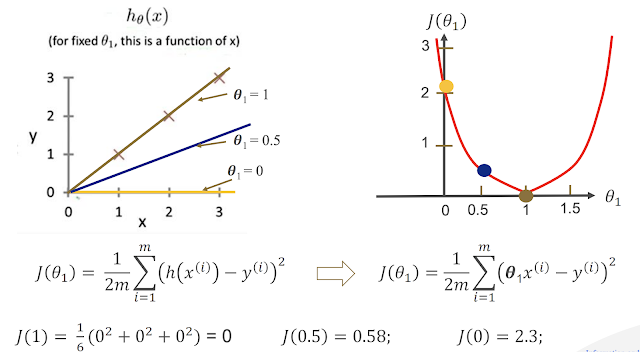How Linear Regression Works (With Python code)
How Linear Regression Works
A simple step-by-step guide with explanation + Python code
What is Linear Regression?
Linear Regression is a mathematical method for drawing the best straight line through a set of points. Imagine you're looking at different houses, and you notice something interesting:
Small houses cost less Big houses cost more
Now, you want to guess the price of a house just by knowing how big it is. So, you look at many houses and write down their size and price.
Then, you draw a straight line through all the dots on your paper. That line shows the pattern: as the house gets bigger, the price goes up.
That line is what we call a linear regression line helps us predict something — such as house prices — based on known information, like size.
Simple Example:
Imagine you know the sizes of some houses and how much they sold for. Now, if a friend asks,
“How much would a 1500 sq ft house cost?” → Linear regression helps you answer that question!
Step 1: The Equation of a Line
The core idea is to draw a line:
Where:
-
= input (e.g. house size)
-
= predicted output (e.g. price)
-
= intercept (where the line crosses the y-axis)
-
= slope (how much price increases per unit of size)
This equation is referred to as our hypothesis or model.
Step 2: Cost Function – How Good is Our Line?
To draw the “best” line, we need to know how far off our predictions are from real data.
We use something called a Cost Function (specifically, Mean Squared Error):
This formula means:
-
Take the difference between the prediction and the actual result.
-
Square it so negatives don’t cancel out.
-
Add them all and take the average.
The smaller this value, the better our line.
Step 3: Gradient Descent – Making the Line Better
We now want to adjust θ₀ and θ₁ so the line gets better and better.
Gradient Descent is an algorithm that does exactly that:
Where:
-
= learning rate (how fast to move)
-
= slope of cost (how to adjust)
Imagine you’re walking downhill — the goal is to reach the bottom (lowest error).
Step 4: Code Example in Python
Let’s code linear regression from scratch!
Goal: Predict house prices based on size
1. Import Libraries and Dataset
import numpy as np
import matplotlib.pyplot as plt
# Data: size (sq.ft) and price (lakh Taka)
X = np.array([280, 750, 1020, 1400, 1700, 2300, 2900])
Y = np.array([7.0, 22.4, 29.0, 40.9, 52.3, 70.5, 85.1])
2. Normalize Data
To make training smooth and fast, we scale everything between 0 and 1.
X_max = np.max(X)
Y_max = np.max(Y)
X = X / X_max
Y = Y / Y_max3. Initialize Model
m = len(X)
X_train = np.ones((2, m)) # Add bias feature (x0 = 1)
X_train[1, :] = X
Y_train = Y.reshape(1, m) # Make sure shape is (1, m)
def init_theta():
return np.random.rand(1, 2) # Random start for θ0, θ1
4. Define Key Functions
# Predict
def forward_prop(theta, X):
return theta.dot(X)
# Cost Function
def compute_cost(h, Y):
return (1 / (2 * m)) * np.sum((h - Y) ** 2)
# Gradient calculation
def backward_prop(h, Y, X):
return (h - Y).dot(X.T)
# Update rule
def update_theta(theta, gradient, alpha):
return theta - (alpha / m) * gradient
5. Train with Gradient Descent
def train(X, Y, alpha, iterations):
theta = init_theta()
for i in range(iterations):
h = forward_prop(theta, X)
gradient = backward_prop(h, Y, X)
theta = update_theta(theta, gradient, alpha)
if i % 100 == 0:
cost = compute_cost(h, Y)
print(f"Iteration {i} - Cost: {cost:.4f}")
return theta
6. Predict New Prices
X_query = np.array([500, 1500, 2000]) / X_max
def predict(theta, X_vals):
X_query = np.ones((2, X_vals.size))
X_query[1, :] = X_vals
return theta.dot(X_query)
# Train and predict
alpha = 0.1
iterations = 1000
theta = train(X_train, Y_train, alpha, iterations)
predicted = predict(theta, X_query) * Y_max
print("Predicted Prices:", predicted)
Sample Output:
Predicted Prices: [[14.27 44.53 59.66]]
That means:
-
500 sq.ft → approx. 14.27 lakh Taka
-
1500 sq.ft → approx. 44.53 lakh Taka
-
2000 sq.ft → approx. 59.66 lakh Taka
Visualize the Result
# Plot original data and the regression line
X_original = X * X_max
Y_original = Y * Y_max
pred_line = theta.dot(X_train) * Y_max
plt.scatter(X_original, Y_original, color='red', label="Training Data")
plt.plot(X_original, pred_line.flatten(), color='blue', label="Fitted Line")
plt.xlabel("Size (sq.ft)")
plt.ylabel("Price (Lakh Taka)")
plt.title("Linear Regression Example")
plt.legend()
plt.grid(True)
plt.show()


No comments for "How Linear Regression Works (With Python code)"
Post a Comment